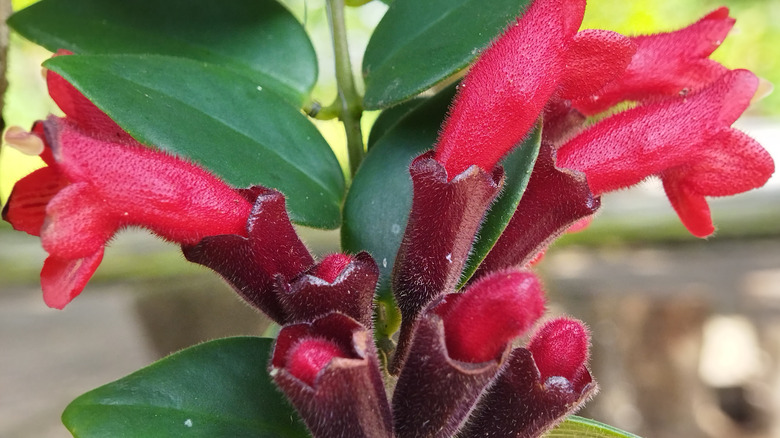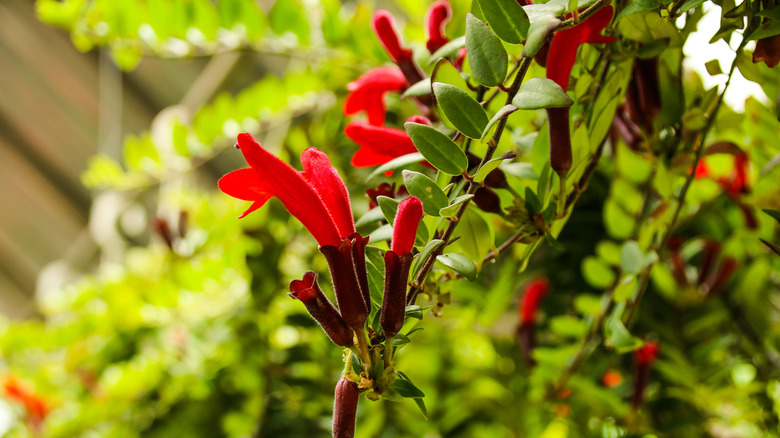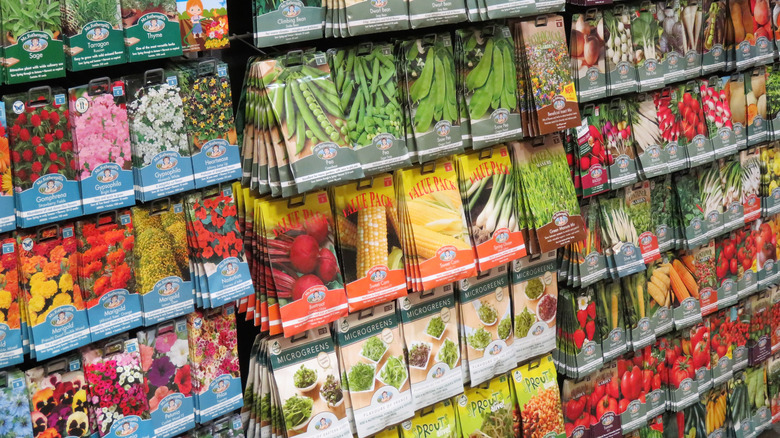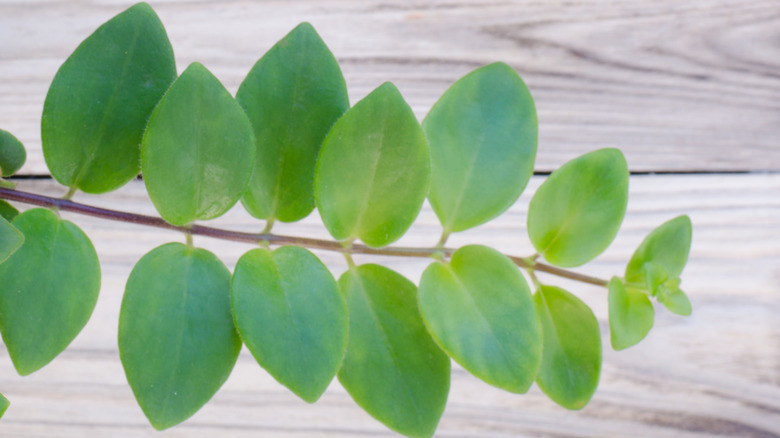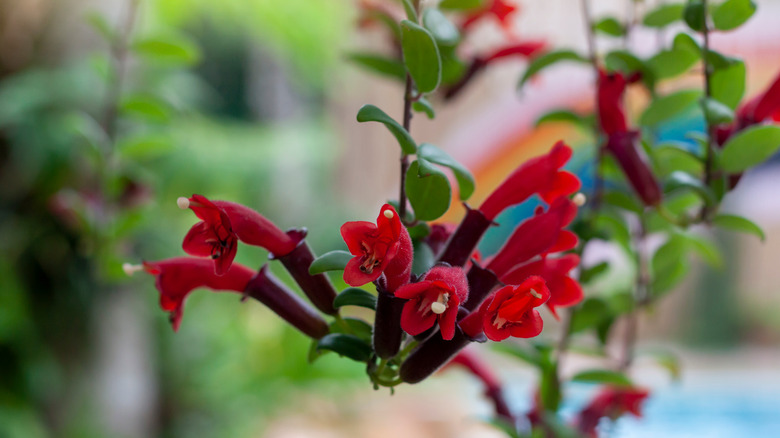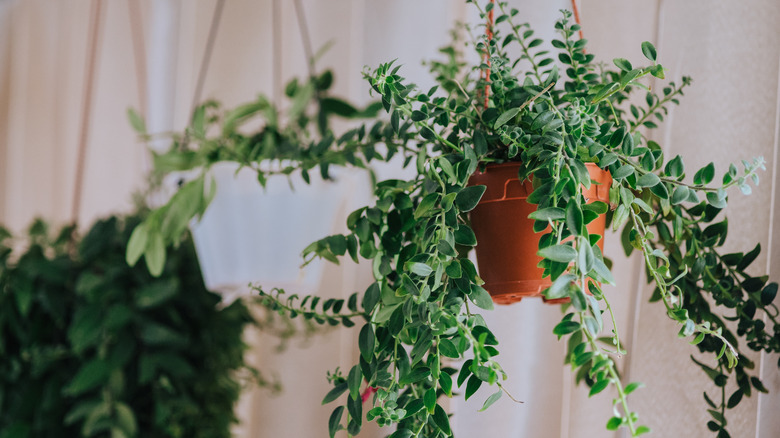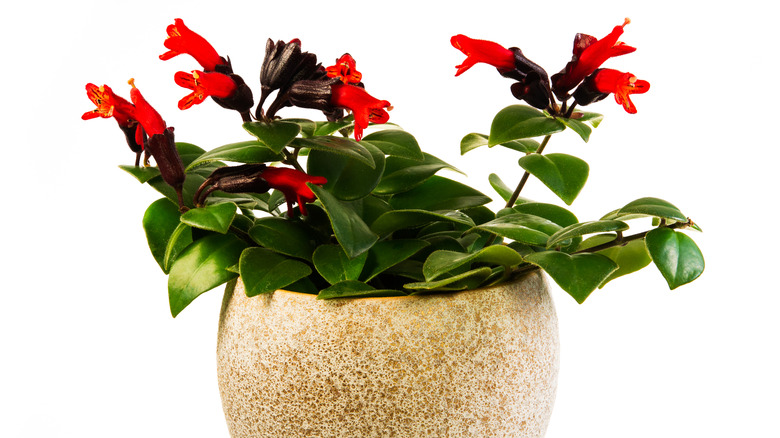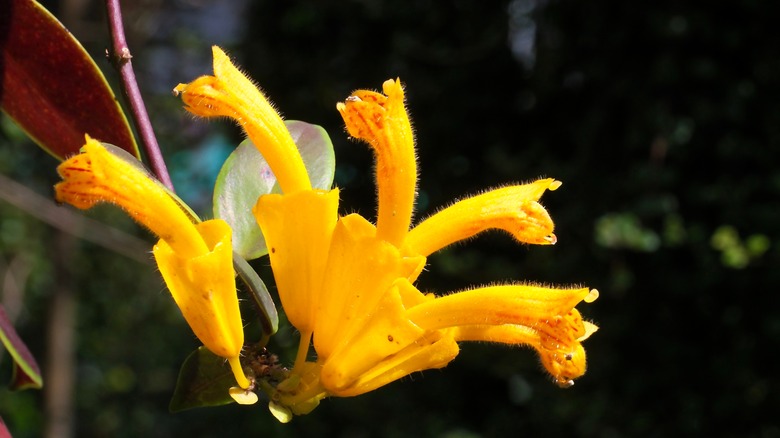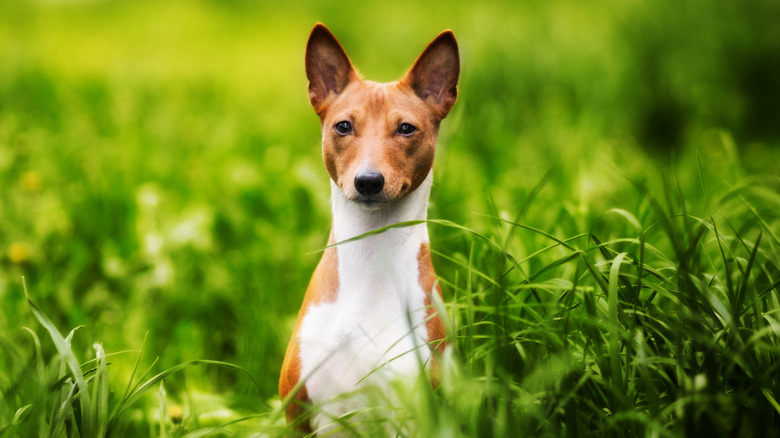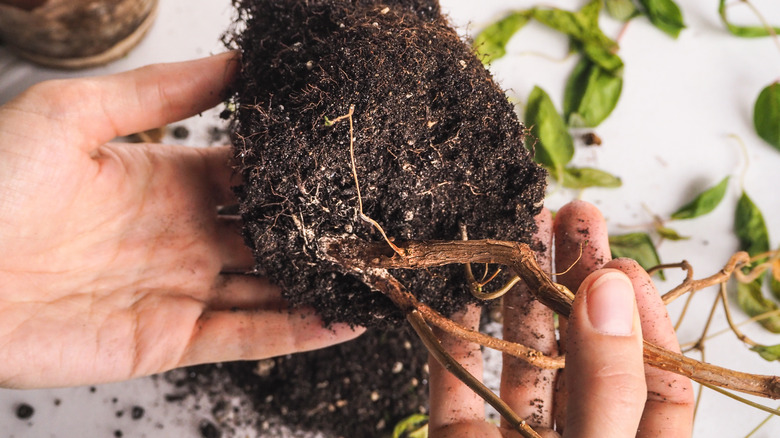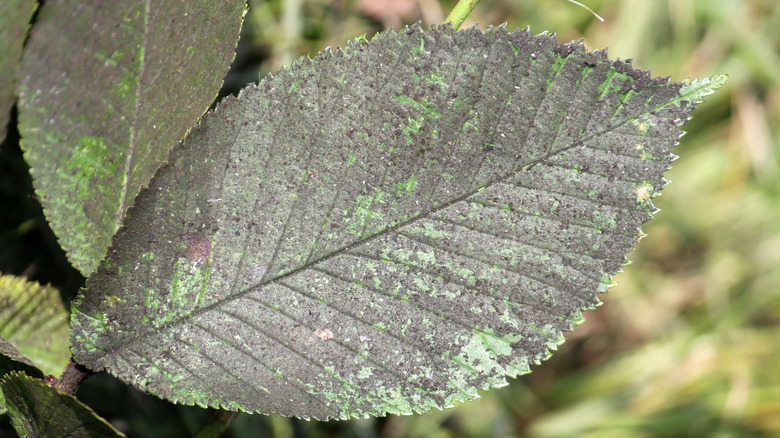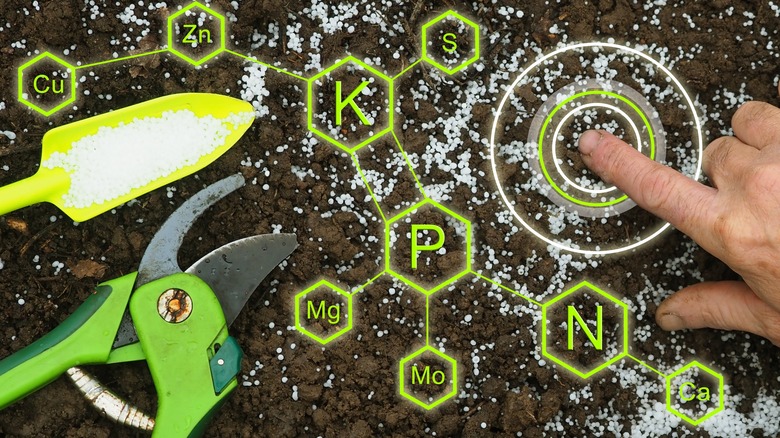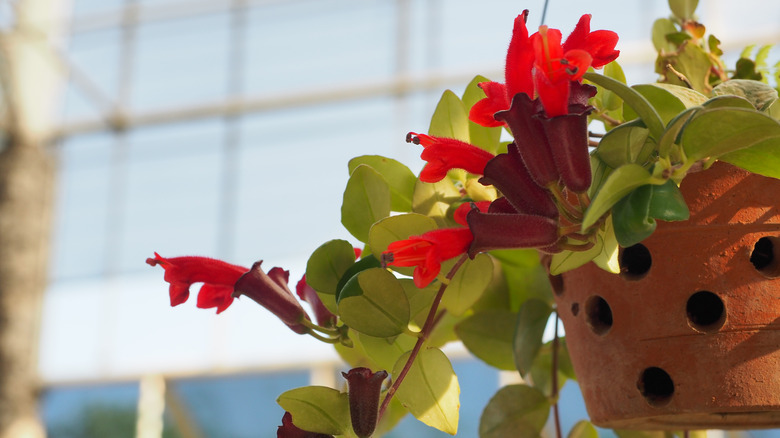What You Need To Know About Caring For A Lipstick Plant
If you've been searching high and low for the perfect plant to gift to your makeup-loving bestie, have we got a treat for you! This unique tropical epiphyte, Aeschynanthus radicans, blooms from a dark tubular calyx that shoots forth bright petaled flowers; together, they look a lot like unfurling tubes of scarlet red lipstick. As such, these plants are affectionately referred to as lipstick plants, and a flowering specimen will brighten up a garden or make a delightful hanging houseplant.
The Aeschynanthus genus can be found growing naturally all over eastern Asia and was officially classified in the early 1820s by William Jack, a botanist who died young and whose work was published posthumously (via The Gesneriad Society). Jack chose the Greek words aischuno and anthus to come up with Aeschynanthus, which translates to "a flower of which to be ashamed." Some believe this is due to a certain body part that the protruding blooms tend to resemble. The genus contains around 150 species, all of which are epiphytic, and some of which are ground creepers. Here, we're concentrating on the most popular species, Aeschynanthus radicans. It's a plant that will require a bit of effort to keep thriving, but the payoff of year-round thick green foliage and ample clusters of attention-grabbing flowers will make it worth your time and effort.
How to use lipstick plants in your landscape or garden
Aeschynanthus radicans is native to Malaysia, which is a clear indicator that it prefers warm temperatures. Therefore, per Missouri Botanical Garden, it can only survive winters in USDA zones 10 and 11. If you live in a warm climate zone, go ahead and knock yourself out sprucing the duller parts of the yard with a flower that is sure to be the talk of your neighborhood. Remember, too, that because lipstick plants are epiphytes, they don't need to be grown in traditional potting soil. Like orchids, they can be situated in the nooks of tree branches where they'll receive everything they need to survive from the air, rainwater, and natural debris around them. Their evergreen vines will complement the woody trunks as the flowers add vibrant splashes of color.
Otherwise, if you prefer to use these plants as ornamental decorations throughout a garden that will experience cold weather, it would behoove you to keep them in hanging baskets that you can move indoors before the temperatures drop. Lipstick plants require bright ambient light, but direct sunlight will do more harm than good. Try planting it in a basket hung from a tree limb. That way, the plants will receive dappled light through the leaves of the canopy. The trailing vines would also do well trained along the underside of a pergola. Also, the tubular flowers are filled with nectar that will attract hummingbirds to your yard.
How to grow a lipstick plant from seed or layering
For those who like to start from scratch, you can grow an Aeschynanthus from seed, although a packet of seeds for this relatively rare plant may be difficult to find at a commercial outlet. What you can do, if you have access to a thriving plant, is experiment with collecting seeds. Dave's Garden notes the importance of waiting until the seed pods are dry before removing them from the plant. Seeds can also be harvested from overripe fruit; just remember to clean them thoroughly and allow them to dry.
According to The Garden Helper, layering is an easy propagation technique that works well with these plants. To properly layer, place a new pot with potting soil next to the existing plant and stretch a vine over to it. Find a spot along the stem with a leaf node and gently push it down into the new soil; use something like a bent piece of wire to hold it in place, and cover it with a bit more soil. With a little luck, this buried stem segment will grow its own set of roots over time, at which point you can sever the vine to separate the new plant from its mother plant.
How to propagate a lipstick plant from cuttings
Starting by seed can be a little too labor-intensive for many of us, and if that's the case for you, consider propagating by cutting. It could be that you already have your own lipstick plant and want to cultivate more of it in other parts of the garden, or perhaps you visited a friend with one and were so taken by the unique flowers you found yourself refusing to leave until they let you take a piece of it home. (No shame, we've absolutely been there ourselves!) Either way, only take a cutting from a healthy plant, and if you're able to, snip off two or three 8 to 12-inch cuttings from the longest vines.
Cuttings from an Aeschyanthus should prove no more difficult than any other plant to propagate. You'll simply remove the leaves from the base of the stem and submerge the stem in water. The reason for taking a relatively long cutting is two-fold: The more leaf nodes (the points where you removed the original leaves) on each stem, the more opportunities for new roots to grow, and the longer the bare stem, the more balanced (less top-heavy) your cutting will be in the water. Roots grow faster in warm environments, so keep that in mind when finding the best sunny spot for your stems. Wait until you see roots developing at the points of the leaf nodes, and once they're about 1 inch long, move your cuttings into starter pots with nutrient-rich, well-aerated potting soil.
General care guide for lipstick plants
Think about its origins in the tropical jungles of Malaysia and Thailand when considering the needs of your Aeschynsnthus radicans as it begins to grow and take shape. Warm weather, relatively high humidity, and bright indirect or dappled light are the keys to a thriving lipstick plant, which prefers a bit of protection from strong sun rays rather than being in an exposed position in the middle of your garden. Set up with appropriate conditions, these plants will grow cascading vines with flowers, each of which will be about 1 to 3 inches long, says NC State Extension Gardener.
Lipstick plants can bloom for most of the year if they stay warm enough, and they stay warm if the soil (and not the air) is between 65 to 70 degrees Fahrenheit. It's also okay to keep them as annuals knowing that you'll plant new ones each year. Lipstick plants will tolerate a stretch of drought better than sitting in standing water. They can handle a regular watering schedule, but only with well-draining soil and containers with unblocked drainage holes. Stay aware of this important aspect of their care.
Winter care guide for lipstick plants
Winter is a time of rest for us, and many of our plant friends also appreciate a break. For flora care, that generally means cutting back on scheduled waterings, ceasing fertilization, and understanding that they can't all be in constant bloom. The reason plants need less water and no food throughout winter is that they temporarily stop growing as a natural response to receiving less light. This goes for both houseplants and garden plants we bring in for a few months at the end of autumn.
A warm-weather lipstick plant will tolerate slightly cooler temperatures throughout winter. Still, if the ground in your area goes below 50 degrees Fahrenheit, you will see leaves die off and fall from the stems (via NC State Extension Gardener). Bringing your plants indoors should avoid this, but there are caveats. Be careful not to place your Aeschynanthus close to heating vents. Also, keep it clear of cold air flowing in from drafty windows. Another aspect that requires attention is humidity since indoor heat sources can quickly suck the moisture out of the air, and these tropical vines are accustomed to year-round dampness. There are plenty of ways to raise the humidity level in your home. If you're not in a position to invest in a dedicated humidifier for that one rare plant you decided to cultivate this year, try regular misting or move it to the most humid area of your home, like a windowed bathroom, kitchen, or laundry room. A humidity level of 50% should be the minimum; try for higher if you can.
Repotting and growing a lipstick plant indoors
When growing a lipstick vine indoors, it will handle a bright sunny window better than it would direct sunlight outside, but don't forget that too much harsh sun can lead to scorched leaves. These plants are somewhat prone to root rot, so water thoroughly on an occasional basis, allowing the first few inches of soil to dry before watering again. Stick to well-draining, aerated substrates and consider irrigating plants from the bottom instead of pouring water over the top of the soil. This will help prevent the lower leaves from succumbing to rot.
Well-known gardening expert and TV host Melinda Myers shares that Aeschynanthus radicans blooms most profusely when left to become a bit root bound. This is common for flowering plants, which means that you won't need to repot yours very often. When you're certain it's time to move your lipstick plant into slightly bigger digs, use the same kind of potting mixture in its new container, gently support the base of the stem as you flip the original pot over and slide it out, then settle it into its new home with a little more soil and a good watering.
Lipstick plant varieties
If you like the overall look of the lipstick plant but prefer something other than bold red flowers, there are a few other varieties worth checking out.
- Aeschynanthus radicans 'Tangerine' is pretty easy to figure out — same plant and flower structure, just orange blossoms instead of red. Similarly, the 'Jack' cultivar pictured above blooms in a bright yellow hue.
- Aeschynanthus radicans 'Curly' offers a different type of foliage altogether. Each leaf curls back towards the stem, so the vines resemble green holiday paper chains or Hoya carnosa rope plants.
- Aeschynanthus longicaulis goes by the common names of marmoratus and/or black pagoda. Until it blooms, you may have no idea it's from the lipstick genus; in fact, black pagodas also resemble other hoyas due to their thick, glossy, zebra-striped leaves.
There's a somewhat rare, cold, hardy lipstick plant cultivar that hails from the mountains of northern Vietnam, which would be the go-to option if you wish to make the most of your autumn garden and perhaps push some color into the winter months. Aeschynanthus buxifolius has a boxier shape to its leaves, so it gets its species epithet from Buxus (the boxwood genus name). Nursery Management notes that these winter warriors can survive temperatures below 20 degrees Fahrenheit, but 13 degrees proves too cold. Food for thought, depending upon where you live.
Is the lipstick plant toxic or safe for pets?
Simply put, the Aeschynanthus genus is included on the ASPCA's list of nontoxic plants for pets. That's great news for the houseplant-and-animal-obsessed, but Pet Health Network still advises caution when mixing the two. Cats especially tend to enjoy snacking on houseplants ... all houseplants. Dr. Justine Lee explains that ingesting too much of just about any plant can lead to gastrointestinal issues, including vomiting, diarrhea, and drooling for the felines in our lives. And yet, they keep doing it. They may be trying to up their fiber intake, or they may like how it feels in their mouths — we may never know. Either way, when cohabitating with pets, it's generally advised to keep your houseplants elevated out of reach.
One tidbit that might help keep your pets disinterested in your lipstick plant is that the flowers are considered malodorous. Of course, stinky blossoms may not be the best for the inside of your house, but hopefully, the smell will convince your cats and dogs to steer clear.
Common diseases with lipstick plants
For the most part, lipstick plants do not have to deal with too many diseases or issues outside of the norm for indoor plants, but it will be important for you to keep an eye on potential root rot, notes NC State Extension Gardener. The species epithet of radicans actually refers to rotting stems, which are usually caused by improper watering. Too far gone, root rot is a condition that is very difficult to turn around. Sometimes you can trim back affected roots and allow them to dry out before repotting the plant in a more appropriate container. Missouri Botanical Garden also suggests potentially rooting cuttings from the shoots to grow a new plant, provided you can find healthy shoots.
Botrytis blight, also called gray mold, is known to be an issue for outdoor Aeschynanthus lipstick plants. Caused by Botrytis cinerea spores, per the University of California Agriculture & Natural Resources, this fungal disease may look like translucent spots at first. Still, they will turn brown as they infect every part of the plant until it eventually dies. In the yard, the mold spores breed in moist areas and among unattended piles of decaying debris. The spores are also airborne, so they can enter your home and infect houseplants, though less likely. It's most important to improve environmental conditions to avoid mold growth in the first place. Clear away and discard surrounding weeds and debris, remove naturally decaying parts of the plant (fallen leaves, spent flowers, etc.), and do what you can to ensure a good amount of airflow around the foliage.
Common pests to look out for with lipstick plants
Aphids are the bane of many a home gardener, and for good reason. They swarm young flower buds, can stunt the growth of your plants, and leave behind sticky sugar-packed residue that invites ants and yellowjackets to join the insect invasion. Called honeydew, the residue doesn't directly harm anything itself, but the University of Minnesota Extension warns that it can compound your issues by creating an environment susceptible to a fungus called sooty mold. As seen in the image above, sooty mold covers leaves in unattractive black spots, but it is not an actual disease.
Neither sooty mold nor aphids and their honeydew spew are likely to kill a lipstick plant, yet the discoloration and tacky coating should be avoided whenever possible. Aphids can easily be knocked off of infected plants with a power wash. Temporarily bring houseplants outside to give them a strong spritz from the garden hose, which will also rinse away the honeydew. If that doesn't take care of the problem, look to low-risk insecticides such as plant-based neem spray and insecticidal soaps. Thoroughly coat leaves on both sides; recheck plants often and reapply whenever necessary.
Best fertilizer practices for lipstick plants
A trusted nursery professional will be your best line of defense when putting together an overarching fertilization plan for your landscape or garden, but if you're focusing on a single lipstick plant, you'll be able to get by with general knowledge. Particularly for flowering plants, the ratio of nitrogen, phosphorous, and potassium (NPK) in a fertilizer formulation matters because each element helps a plant differently. For example, a fertilizer high in nitrogen will boost the growth of thick, green foliage, but it won't do anything to encourage blossoms. For more flowers, you might need to move away from a standard fertilizer with a balanced NPK ratio of 10:10:10 and, instead, find one with a higher phosphorous level. You'll see this labeled as 5:10:5.
A 2021 study from the National Symposium on Floriculture Research reviewed the efficacy of using gibberellic acid specifically to increase flower bud production in Aeschynanthus radicans lipstick plants. Defined by ScienceDirect as plant hormones that can regulate plant growth, gibberellic acids (or gibberellins) did, in fact, benefit bud growth in the study. They were applied in conjunction with a fertilizer that was lower in nitrogen and higher in both phosphorous and potassium. Science experiments in the garden can be fun, however, the EPA warns that too much phosphorous can produce harmful runoff in waterways. At the end of the day, be careful when working with chemical concoctions.
How to get a dormant lipstick plant to re-bloom
It's not uncommon for indoor plants to stay lush and green but not flower, which is usually the result of either one or two issues. First and foremost, check that your plant is receiving a sufficient amount of light. A low light situation stops flowers in their tracks, so make sure you're shooting for sufficient light instead of merely adequate. In order to flower, these guys need to be close to a bright window. If you don't have a sunny spot for them, you'll need to supplement the area with grow lights.
Another issue that could be reducing the number of blooms you're getting is that the soil stays dry for too long in between waterings. Epiphytic plants are known to survive a bit of drought, but if spells happen too frequently or for an extended period of time at once, it could be a sign that the potting soil is becoming hydrophobic. Scared of water? Not exactly. Hydrophobic soil repels water, meaning it never absorbs enough to become fully saturated, explains UC Master Gardeners. It can happen when a plant completely dries out, and peat moss within the mix is often to blame as it's notoriously difficult to re-saturate. If you think this might be occurring, bottom watering may do the trick. For a much quicker and more substantial fix, try submerging the entire container in a large tub of water; hold it down until all the air bubbles rise to the top.
